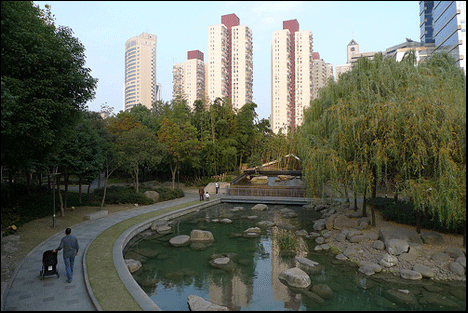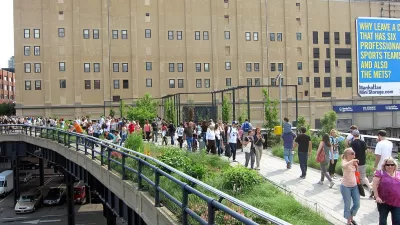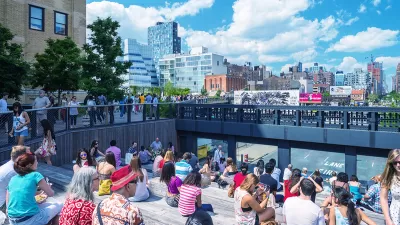The excesses of the "landscape urbanism" aside, Michael Mehaffy believes landscape architects are well positioned to lead the way towards positive change in the urban landscape. Here's why.
Not long ago in this forum I offered a rather pointed critique of a movement in landscape architecture known as "Landscape Urbanism." The critique focused on several remarkable claims: the magical belief that the form of open space by itself can generate good-quality urban form; the parochial conceit that ecological landscape by itself constitutes ecological settlement; and most seriously, the spurious rationalization of "horizontality and sprawl" as allegedly eternal and unchangeable facts of settlement, which must be accommodated rather than transformed.
As I argued, this latter view ignores the evident historical facts, namely, that modern suburban expansion did not arise spontaneously from immutable economic forces, but resulted from comprehensible policy choices, rules and, especially, modern industrial design strategies. (As a seminal example I discussed Le Corbusier's highly influential scheme for suburban expansion, documented in the 1935 book Ville Radieuse.) Designers, complicit in this defective scheme, share a profound responsibility to correct their own mistakes. You broke it, you fix it.
And indeed, the lessons from a number of disciplines (economics, game theory et al.) show that such corrections are possible and, in the age of peak oil and climate change, urgently necessary. (This is all the more urgent in view of the rapid development of China, India and other countries, which are in grave danger of repeating many more of the same mistakes, with profound consequences for resources and emissions.) The time is at hand for effective reform, and there is little place for the same colossal mistakes to be rationalized in a self-indulgent poststructuralism by artist-designers.

But here I would like to offer a more positive view of the role of landscape architects in the important work ahead to get our house in order. After all, while architects have often been over-focused on object-buildings, it is landscape architects who have been the champions of the best figure-ground urbanism in the past – and they can be so again.
In particular, I suggest a number of key emerging topics where landscape architects are uniquely positioned to lead:
Biophilia
Research shows that compact, ecologically efficient cities are much more conducive to human well-being – and much more desirable and appealing – if they contain the beautiful patterns and qualities of artfully structured vegetation. Architects need to take these lessons to heart, in the geometric qualities of their buildings, and their incorporation of interior vegetation, water, light and air. But urbanists also need to take these lessons to heart, in the incorporation of vegetation as part of the connective tissue of the public realm.
This biophilic form language opens up vast new possibilities for expressive aesthetics, while allowing designers to cultivate the essential characteristics of high-quality settlement – something they have not done particularly well of late, as I will discuss below.
Urban Ecology
Ecological neighborhoods need large areas of infiltration and water purification, mitigation of albedo effects, air purification, and other ecosystem services. Landscape architects have the unique expertise to integrate these services into a livable neighborhood with a functional public realm. They alone can transcend the border between urbanism and architecture, and provide an essential connective function.
They can also remind us (and themselves) that ecology is not just about forests and foxes, but equally about the resource-efficiency of human settlements. ("Eco" is Latin for "house," after all.) There can be no overall ecology without an ecology in the very form of settlement.
Landscape Design Innovations
Along with the failed paradigm of greenbelt sprawl, there is an urgent need to retrofit the still-widespread use of mass irrigation, fertilizers, mowers, invasive species, and other ecologically untenable practices. At the same time, cities need to reduce their expenditures on public amenities, which are currently wasted on the high maintenance of ill-conceived and poorly located "open spaces." Thus there is a demand for innovation in native and low-maintenance landscapes, integrated into smart design of functional, well-distributed, well-integrated public spaces.
Imagine the possibilities for new approaches to urban agriculture; edible landscapes; rain gardens; rooftop gardens; living courtyards; paving into pocket gardens; and on. What is on offer seems to be nothing less than a rich canvas for a newly appropriate avant-garde design. (See below.)
Avant-Garde Art
I use this term advisedly. Is it avant-garde any more to employ endless new permutations of what Peter Eisenman has called "Rococo Modernism""as a self-conscious fine art, draped, like so much product packaging, over an outmoded industrial design language? Are we tired yet of what the critic Kenneth Frampton memorably described as "architainment" -- "avant-gardist kitsch, quasi-radical in form but nihilist in content?" Perhaps it is now more avant-garde (and much more exciting) to engage Herbert Simon's conception of design, as "the transformation from existing states to preferred ones."
It is certainly fashionable lately to invoke the latest concepts of complexity science – emergence, morphogenetics, etc. This is a powerful and important subject, to be sure. But perhaps the more radical approach is to move beyond the weakly metaphorical application of these insights to a Modernist sculptural project of aesthetic abstraction, and actually apply them (accurately and skillfully) to the real life of cities? Perhaps it is finally time to take on Jane Jacobs' lessons on "organized complexity" – delivered masterfully and perspicaciously in her first book, now a full half-century ago – and build good livable neighborhoods that actually integrate art with life.
Yes, there is a place, a most important place, for transcendent fine art. But art is a servant of the city too, and of its life -- and it remains responsible to them. Artist-designers are not enfants terrible who have earned the privilege to throw their toys across the cityscape. By commission and by omission, this infantile behavior damages cities, and – no less so -- it trivializes the enduring meaning of art. Yet it is an appalling fact that this attitude still dominates (in various clever, self-confusing guises) in many leading design schools today. That complicated fact obscures, but does not change, its status as a form of design malpractice.
A Functional Public Realm
It is not a coincidence that those cities and parts of cities with well-connected, walkable public realms have been shown to have much lower levels of resource use and emissions per person than those that rely upon a car-dominated suburban model of urbanism. (They also tend to have better metrics of public health, well-being, and social diversity.) A growing body of research shows that the "tailpipe" (the direct combustion of fossil fuel for transportation) is only a small component of the overall impact of such a lifestyle. In addition there is the embodied energy of the vehicles, the operating and embodied energy of the infrastructure (roads, bridges, lights, signals, pipes, pumps, wires), the associated buildings and their inefficiencies, the loss of ecosystem services, and other factors.
Landscape architects have unique expertise to lead the needed re-integration of the public realm into the urban and architectural fabric -- and in that sense, to lead into a more sustainable, more truly "modern" urbanism.
It is not an accident that many of the best urban designers – the best urbanists – have been landscape architects. It would be a tragedy if the profession allowed itself to be marginalized by a lingering reactionary design impulse – one that sanctions the clever repetition of evident malpractice. (Yes, while we're discussing alleged reactionaries, let us remember that turnabout is fair play.) But the new generation of ecological landscape architects does seem genuine in wanting to transcend the limitations of an outmoded Modernism, and to inform design with greater ecological insights. That's something to work with.
Perhaps this doesn't actually amount to "saving the world" (in the admittedly rather hyperbolic title of this paper), but it's a very encouraging shift. So we look forward to the day when the leadership of landscape architecture will finally transcend a tired and irrelevant industrial fine art project, and help to bring about the exciting urban renaissance that is, as evidence suggests, entirely possible.
Michael Mehaffy is an urban design theorist and consultant, and currently Sir David Anderson Visiting Fellow at the University of Strathclyde in Glasgow.

Planetizen Federal Action Tracker
A weekly monitor of how Trump’s orders and actions are impacting planners and planning in America.

Maui's Vacation Rental Debate Turns Ugly
Verbal attacks, misinformation campaigns and fistfights plague a high-stakes debate to convert thousands of vacation rentals into long-term housing.

San Francisco Suspends Traffic Calming Amidst Record Deaths
Citing “a challenging fiscal landscape,” the city will cease the program on the heels of 42 traffic deaths, including 24 pedestrians.

Trump Prompts Restructuring of Transportation Research Board in “Unprecedented Overreach”
The TRB has eliminated more than half of its committees including those focused on climate, equity, and cities.

Amtrak Rolls Out New Orleans to Alabama “Mardi Gras” Train
The new service will operate morning and evening departures between Mobile and New Orleans.

The Subversive Car-Free Guide to Trump's Great American Road Trip
Car-free ways to access Chicagoland’s best tourist attractions.
Urban Design for Planners 1: Software Tools
This six-course series explores essential urban design concepts using open source software and equips planners with the tools they need to participate fully in the urban design process.
Planning for Universal Design
Learn the tools for implementing Universal Design in planning regulations.
Heyer Gruel & Associates PA
JM Goldson LLC
Custer County Colorado
City of Camden Redevelopment Agency
City of Astoria
Transportation Research & Education Center (TREC) at Portland State University
Jefferson Parish Government
Camden Redevelopment Agency
City of Claremont




























